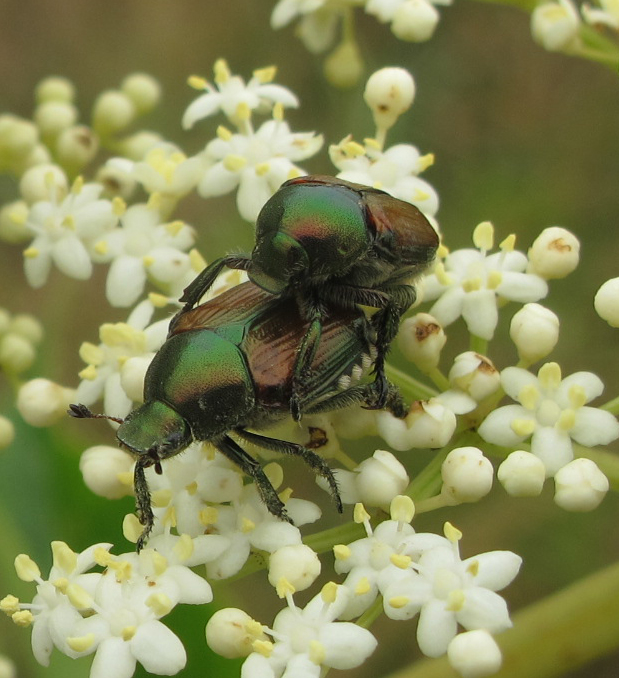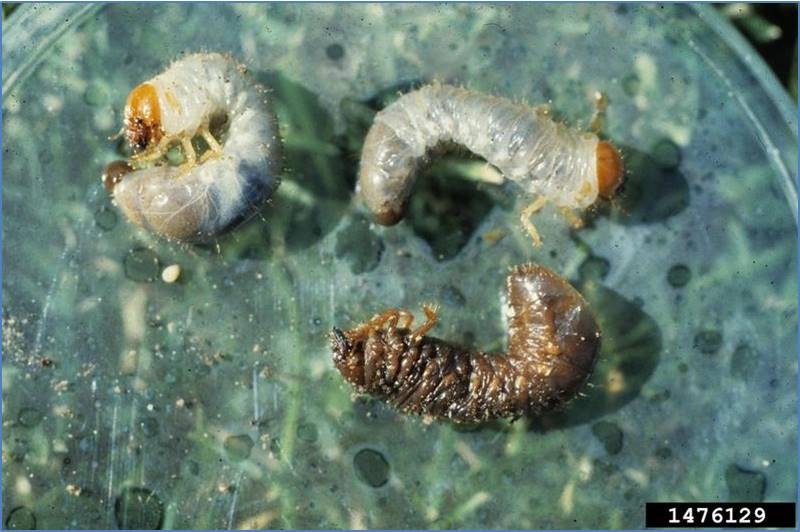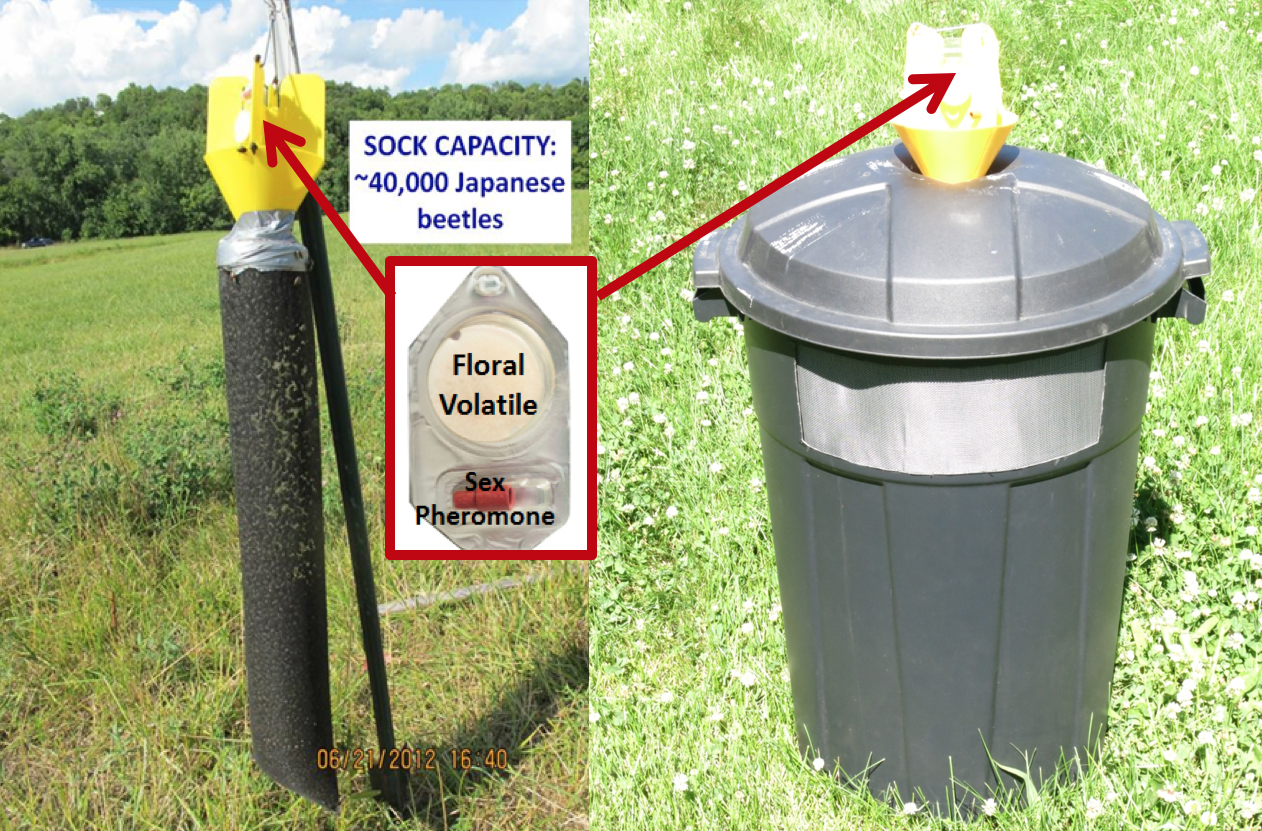Taking an environmentally sensitive approach to pest management
Organic Management Options for the Japanese Beetle at Home Gardens
Published: January 24, 2018
Introduction
Japanese Beetles were accidentally introduced to the east coast in 1916 in a shipment of iris bulbs. Since then they have slowly and steadily made their way westward. The Japanese beetle has become a major pest of crops, lawns, and ornamental plants in Missouri. In fact, 2017 was the year when the highest populations were recorded thus far. To control this invasive pest, many people are interested in using less or no insecticides, and other control options that are safer for home-owners and also compatible with organic production.

Feeding on plant tissue by adult Japanese beetles causes the release of plant volatiles from the damaged sites, and of additional pheromones from females. This results in aggregations of beetles, triggering a feeding frenzy. If you are able prevent beetle aggregations by dislodging or killing the first arrivers, you may be able to limit the damage. Conversely, if a feeding frenzy starts, it will be difficult to remove the beetles unless insecticides are applied.
Seasonal Activity of Japanese Beetles
In mid-Missouri, significant numbers of Japanese beetles begin emerging in mid to late June, the population peaks the second week of July, and declines by early August. The timing of the onset and end of Japanese beetle adult activity may vary by a couple weeks depending on weather. For instance, if warm, humid conditions occur – they will emerge earlier. If it's cold and rainy, they may not become active until late June.
Daily feeding behavior is also subject to weather. If you are checking your plants, you might not see any beetles on a cold, rainy day – but don't assume your pest problems are over! Thousands of Japanese beetles may burst from the ground on the very next day if it's warm and sunny. Feeding damage to plants can happen within 48 hours. Your pest management strategy should be "proactive" not "reactive." Don't wait to see catastrophic damage before acting.
Organic Management Options for the Japanese Beetle
Biological Control
Japanese beetles are not native to the U.S.A., so there are very few natural enemies that could keep them in check. Some species of parasitic wasps that attack Japanese beetles in the grub and adult stages have been introduced into the country, but they are not commercially available. However, there are some pathogens (organisms that cause diseases) that attack the grubs in the soil.
One naturally occurring bacterium that is commercially available is called Milky Spore®, which is an option for controlling grubs in the soil that damage the lawn. When spores of Milky Spore are ingested by Japanese beetle grubs, they die and in the process they release billions of new spores into the surrounding soil. One example of a commercially-available formulation of Milky Spore is produced by St. Gabriel Organics. Cost to treat 2,400 square feet is about $30. This product is most effective when applied in early- or mid-August, when the grubs are actively feeding. The soil must be above 65 degrees F. It works best to apply it just before rainfall, or consider watering in lightly after application to soak into soil. The number of applications recommended by the label should be considered, applying Spring, Summer, and Fall for two consecutive years (six total). While this significantly increases the expense, it is claimed to give faster control, for up to 20 years.

Japanese beetle larvae killed by Heterorhabditis bacteriophora next to two healthy larvae. Picture by Whitney Cranshaw, Colorado State University, Bugwood.org
There are also several species of nematodes (tiny round worms) that attack Japanese beetle and other soil-dwelling grubs. NemaSeek® consists of live beneficial nematodes that actively search for grubs in the soil. Cost to treat 1,600 square feet is about $30. Nematodes need to be mixed with water to apply using a backpack sprayer. Usually, two applications—7 days apart, are recommended. Soil temperature needs to be at least 44 degrees F and it needs to stay moist (water every 3–4 days). Nematodes mostly die in winter so they will need to be reapplied annually.
For both milky spore and nematode applications, be cautious with your expectations! Reduced numbers of adult beetles emerging in 'your' yard doesn't prevent them from flying in from areas that aren't treated.
Insecticides
Application of insecticides to control pests including Japanese beetles should be considered the last resort. When exploring chemical control options, farmers/gardeners should select the lowest risk and the most effective products. While many synthetic insecticides are available to control Japanese beetle in the adult stage, there are very few materials approved for organic pest control. As a general rule, organic insecticides are more expensive than their synthetic counterparts and their residual effect is much shorter. This can actually lead to applying more product on a given area because of the tighter treatment intervals. For example, the cost of spraying PyGanic® 5.0 EC (an OMRI-listed insecticide that is based on pyrethrins) against adult Japanese beetles in one-acre plot is approx. $77.00 per application, using the high label rate. If a person sprays PyGanic twice a week for six weeks then the season-long cost of spraying organic insecticides would amount to $924. In addition, most organic insecticides are no safer to non-target organisms (e.g., pollinators) than synthetic materials.
Before applying a pesticide, always thoroughly read the label and make sure to use the proper personal protective equipment.
Mass Trapping
Mass trapping is a topic surrounded by controversy. Research done at some universities has shown that in certain situations, the powerful lures used in Japanese beetle traps actually attract many more beetles than are caught, which can increase plant damage in the nearby areas. Research done over six years in central Missouri by the Lincoln University Integrated Pest management program has shown that blueberry and elderberry plantings can be protected from Japanese beetles by using a mass trapping system involving a double lure system comprised of a floral-based lure and the Japanese beetle sex pheromone, and a modified catching device. The mass trapping system is deployed outside the cropped area. For blueberries, 7 traps per acre have proven to be effective at suppressing beetles from the cropped area. By using mass trapping, over 15.5 million Japanese beetles have been killed in a 6-year period in two farms without spraying the crop with insecticide.

Mass trapping designs developed for Japanese beetle control.
Left: Mass trapping design made of an aluminum mesh sock 4 feet long by one foot in diameter. Right: High-capacity mass trapping system intended to be used by farmers on farms or in rural areas. Japanese beetle lures are always used in conjunction with trap tops that consist of yellow panels that intersect at 90° with a funnel underneath ending in a wide rim. Beetles hitting the vane fall through the funnel into the collecting device.
While mass trapping of Japanese beetles is a practical option for farms, mass trapping for residential areas needs to be carefully considered before implementing. A single trap in most situations will be inadequate. Four traps or more are likely needed to establish a perimeter to prevent them from moving into your landscape. One also needs to consider that emptying the traps takes time and should be done at least weekly, more often if needed to keep from overflowing. Disposing of them is unpleasant, as they have a rather foul 'fish-like' odor (due to proteins breaking down). While chickens and pond fish will eat them, if given too many for too long, will either get too full or lose interest. Some unwanted wildlife e.g. raccoons may be attracted to the traps or dead beetles. Whether or not to use mass trapping depends on several factors including costs, value of the crop, other options available, time commitment, and type of setting (farm / rural areas versus urban neighborhoods). Consider, the entire trapping period may last for 6 to 8 weeks! If you are interested in learning more about mass trapping, check out this Newsletter: Mass Trapping as an Organic Management Option for the Japanese Beetle on Farms
Cultural Controls
In agricultural settings Japanese beetles numbers can be reduced by tillage, groundcovers and, to some extent, by managing irrigation regimes. For example, researchers from Michigan State University found that Japanese beetle numbers drastically increased with buckwheat planted between rows of blueberry as compared to clover, ryegrass, or bare soil. Another study found that female Japanese beetles choose to lay their eggs more often and in higher numbers in fescue vs. warm season turf grasses. Females also choose to lay their eggs in moist soil, so withholding irrigation during peak egg-laying season can help reduce grub populations as well.
Careful selection of Plant Varieties
Many plant varieties are not favored by Japanese beetles and therefore are unlikely to suffer significant feeding damage (see table below).
Plant Varieties Least Favored By Japanese Beetles |
Plant Varieties Most Favored by Japanese beetles |
Arbovitae |
American and English elm |
Boxelder |
Birch |
Boxwood |
Black walnut |
Clematis |
Elm |
Dogwood |
Grape |
Euonymus sp. (burning bush, etc.) |
Hawthorn |
Forsythia |
Hollyhock |
Hemlock |
Horse-chestnut |
Hickory |
Japanese and Norway maple |
Holly |
Larch |
Juniper |
Linden |
Lilac |
London planetree |
Magnolia |
Malus spp. (crabapple, apple etc.) |
Mulberry |
Mountain ash |
Northern red oak |
Pin oak |
Pine |
Prunus spp. (flowering cherry, etc.) |
Red and silver maples |
Pussy willow |
Redbud |
Rose Spruce |
Sweet gum |
Raspberry |
Tulip poplar (tuliptree) |
Virginia creeper |
Yew |
Willow |
The above information was taken from Iowa State University, with permission.
http://www.ipm.iastate.edu/ipm/hortnews/2010/7-14/japanesebeetle.html
References:
Gordon, F.C. and Potter, D.A. 1985. Efficiency of Japanese beetle (Coleoptera: Scarabaeidae) traps in reducing defoliation of plants in the urban landscape and effect on larval density in turf. Journal of Economic Entomology 78: 1381-1384.
Ladd T. L., Klein, M. G. and Tumlinson, J. H. 1981. Phenethyl propionate + eugenal + Geraniol (3-7-3) and Japonilure – a highly effective joint lure for Japanese beetles (Coleoptera, Scarabaeidae). Journal of Economic Entomology 74: 665-667.
Piñero, J.C. and Dudenhoeffer, A.P. 2018. Mass trapping designs for organic control of the Japanese beetle, Popillia japonica (Coleoptera: Scarabaeidae). Pest Management Science (in press).
Piñero, J.C. and Wilson, J.T. 2013. Mass trapping: a potential organic management option for Japanese beetles. Midwest Organic and Sustainable Education Service Conference, La Crosse, Wisconsin.
Potter, D.A., Powell, A.J., Spicer, P.G., and Williams, DW. 1996. Cultural practices affect root-feeding white grubs (Coleoptera: Scarabaeidae) in turfgrass. Journal of Economic Entomology 89: 156–164.
Szendrei, Z. and Isaacs, R. 2006. Ground covers influence the abundance and behavior of Japanese beetles. Environmental Entomology 35: 789-796.
Wood, T.N., Richardson M., Potter, D.A., Johnson, D.T., Wiedenmann, R.N., and Steinkraus, D.C. 2009. Ovipositional references of the Japanese beetle (Coleoptera: Scarabaeidae) among warm- and cool-season turfgrass species. Journal of Economic Entomology 102: 2192-2197.
Subscribe to receive similar articles sent directly to your inbox!
REVISED: February 21, 2017